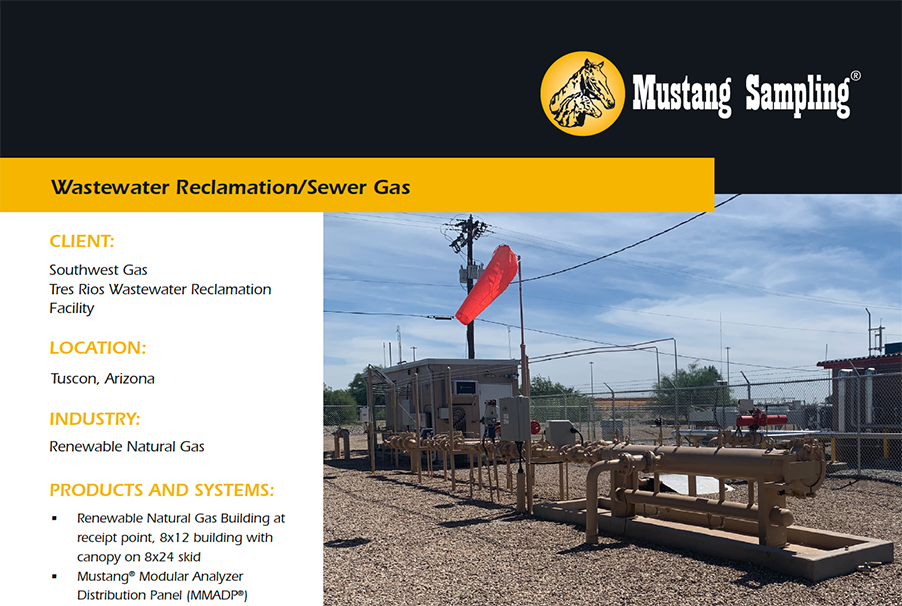CLIENT:
Southwest Gas
Tres Rios Wastewater Reclamation Facility
LOCATION:
Tuscon, Arizona
INDUSTRY:
Renewable Natural Gas
PRODUCTS AND SYSTEMS:
- Renewable Natural Gas Building at receipt point, 8×12 building with canopy on 8×24 skid
- Mustang® Modular Analyzer Distribution Panel (MMADP®)
- Mustang® Moisture Analyzer
- Musang® P53 Sample Conditioning System
- Pony® Heated Probe Enclosure
- Mustang® Heat Trace Tube Bundle
- MJTHR® – 4 stage regulator
- Gas Chromatograph
- OMA 300 H2S Analyzer
- O2 Analyzer
- CO2 Analyzer
THE BACKGROUND
Southwest Gas, Arizona’s biggest gas utility, has linked its system to Pima County’s Tres Rios Wastewater Reclamation Facility in Marana, a renewable natural gas (RNG) plant. Pima County for many years has used raw biogas to fully power the engines used at the Tres Rios sewer plant. As part of a major upgrade to the sewer plant in 2014 a study was conducted to evaluate whether or not it would be more economical to build a plant to refine the Tres Rios’ raw biogas into Renewable Natural Gas for Sale. The final report concluded in favor of the new plant. The county signed an agreement with a biogas joint venture to build the RNG treatment facility and market the gas.
THEIR CHALLENGE
In the later part of 2014, joint venture expected to buy the RNG folded and the plant was unable to find another ready customer. In 2019, Pima County decided to move forward and build its own Renewable Natural Gas plant and partner with Southwest Gas.
As part of the efforts to help customers and the communities achieve sustainability and emissions reductions goals, Southwest Gas is acting as a catalyst to bring sources of Renewable Natural Gas to end users. Southwest Gas’ plans for the sustainable energy future and Pima County’s decision to opt for a higher-purity system in order to market the highest-quality gas led to finding a company to connect the 2 gas feeds together for Pipeline Quality.
Wastewater treatment plants typically produce methane-rich gas from the anaerobic decomposition of waste solids, sludge, or biosolids in the municipal wastewater. Constituents of Concern (COCs) such as metals, sulfur compounds, and siloxanes may be present in the gas because these materials are present in waste streams. With processing to increase the methane content, reduce water, and remove COCs, wastewater treatment plants are able to produce RNG that meets tariff requirements for injection into natural gas pipelines. Continuous monitoring thereafter and periodic onsite sampling before injection into the natural gas pipeline insures a reliable future supply.
MUSTANG SAMPLING’S RENEWABLE NATURAL GAS MONITORING AND SAMPLING BUILDINGS
The final gas quality is measured at the interconnect between the RNG plant and Southwest Gas’ natural gas pipeline. The continuous monitoring begins by extracting an RNG sample through a probe housed in the Pony Heated Probe Enclosure. The extracted gas is transferred via the patented Mustang® Heat Trace Tube Bundle to a Mustang P53® Sample Conditioning System which maintains the temperature of the sample well above the hydrocarbon dew point. The representative sample is distributed using a Musang Modular Sample Control Panel to various analyzer within a Mustang Sampling industrialized building. The RNG feed is typically monitored continuously for CH4, CO2, H2S, nitrogen, and oxygen to make sure it meets the tariff parameters set by Southwest Gas. Safety mechanisms at the interconnect allow the pipeline to reject any RNG not meeting standards into the natural gas pipeline.
THE ARTIST BEHIND THE EVOLUTION OF ENERGY
Pima County commissioned the locally famous muralist and public artist, Ignacio Garcia, to adorn the highly visible facility. Ignacio is best known throughout Arizona and California for his 3D chalk and large photo-realistic murals. The commissioned mural wraps the building at the Renewable Natural Gas interconnect between the Tres Rios Wastewater Reclamation Facility and Southwest Gas, capturing a variety of energy related themes in a style that only Ignacio could deliver.
Through Ignacio’s work, he offers an innovative and unique point of view that challenges the viewers emotional and physical reaction. He believes research, reflection and exploration of the topic before the finished piece will invoke an authentic, unpredictable and organic response from each individual viewer. Through this belief system Ignacio was able to facilitate an engaging brainstorming session with the wastewater facility crew which ultimately led to the evolution of energy through their eyes.
Ignacio Garcia commented: “It was the wastewater management crew, the people that actually work there, they came up with this idea of the evolution of our energy. How it evolved to now, to the future, through wildlife. We went back and forth and then they mentioned a dinosaur. At first I was like…really? and then I knew exactly what to do with it. The whole mural came together and in the end I tide it up with some artist perspective.”


